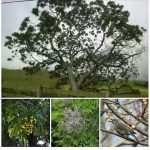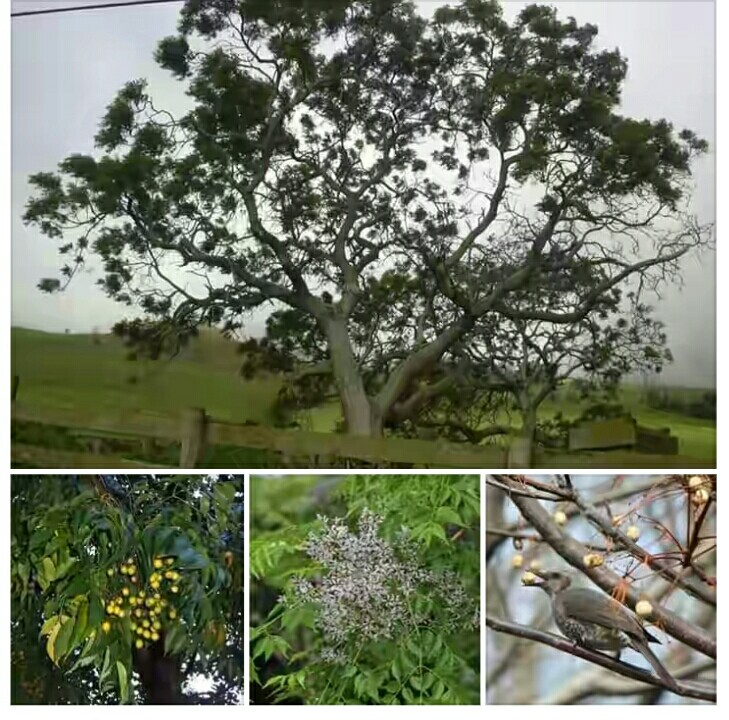Melia azedarach or Barbados lilac Chinaberry, China tree, Persian lilac, Pride of China, Pride of India, Syringa, Azedarach, White cedar, Bead tree, Umbrella tree (English) or Kurnan Masar, Kurnam nasara, Ichen kurdi (Hausa) or Eke-oyinbo (Yoruba): A useful but poisonous deciduous tree
DESCRIPTION AND OCCURRENCE: Melia azedarach is a small to medium deciduous tree attaining a height of 5-15 m and a stem diameter of 110 cm. It is an attractive ornamental and shade tree with a high lateral branching. Hardy and drought resistant. Ferny foliage turning yellow in autumn. Leaves are dark green on the upper surface and paler underneath. They emit pungent smell when crushed. Because of the divided leaves, the generic name is derived from the Greek ‘melia’ (the ash); the specific name comes from the Persian ‘azzadirackt’ (noble tree). Flowers are purple and fragrant. Fruits or berries are yellow, nearly round, smooth and so hard as a stone, containing 4 to 5 black seeds. Melia azedarach is native to tropical Asia. It is wide spread and naturalized in most of the tropics and subtropical countries. It was introduced and naturalized in Philippines, United States of America, Brazil, Argentine, many African countries and many Arab countries.
Medicinal Uses and Health Benefits of Melia azedarach
Leaves are cooked, but have bitter flavor; they are used as a pot-herb, in curries, soups etc. THE FRUIT IS HIGHLY TOXIC TO WARM-BLOODED ANIMALS. RIPE FRUITS ARE MORE TOXIC THAN GREEN ONES. AS LITTLE AS SIX FRUITS HAVE CAUSED NAUSEA, SPASMS AND FATALITIES IN CHILDREN. ALL PARTS OF THE PLANT CONTAIN TOXINS THAT CAN CAUSE GASTROINTESTINAL TRACT IRRITATION AND DEGENERATION OF THE LIVER AND KIDNEYS. A cooling drink is made from the sap – it is actually a gum. This gum is tasteless, clear to dark amber and of good solubility.
The sap is obtained from incisions that are made near the base of the trunk in the spring. The leaf juice is anthelmintic, antilithic, diuretic and emmenagogue. A decoction is astringent and stomachic. A decoction is used to treat diarrhoea.
The leaves are used externally to treat skin conditions such as scabies and itch. A decoction is used as a gargle to treat tooth problems and strengthen the gums. The flowers and leaves are applied as a poultice in the treatment of neuralgia and nervous headache. The stem bark is anthelmintic, astringent and bitter tonic. It is used as a tonic in India.
The root bark is emetic, emmenagogue, purgative and vermifuge. It is highly effective against ringworm and other parasitic skin diseases. It can be harvested at any time of the year and is used fresh or dried. The fruit is antiseptic and febrifuge. The pulp is used as a vermifuge. The fruit is harvested in the autumn when it is fully ripe and can be used fresh or dried.
The seed is antirheumatic. It is used externally. A gum that exudes from the tree is considered by some to have aphrodisiac properties. THIS PLANT SHOULD BE USED WITH CAUTION, PREFERABLY UNDER THE SUPERVISION OF A QUALIFIED PRACTITIONER. EXCESS CAUSES DIARRHOEA, VOMITING AND SYMPTOMS OF NARCOTIC POISONING. Extracts of fruits, seeds, leaves of M. azedarach have shown many characteristics of medicinal and pesticidal activities against several pathogenic and pest organisms, respectively.
In medical and veterinary entomological investigations, extracts of M. azedarach showed efficacy against the tick Boophilus micoplus, the malarial vector Anopheles stephensi, the dengue vector, Aedes aegypti and the human lice Pediculus humanus capitis. Insecticidal, acricidal, fungicidal and rodenticidal potentials of extracts made from various parts of the plant have been proven by many workers in several countries.
FOR FURTHER READING SEE:
1. Hocking D. 1993. Trees for Drylands. Oxford & IBH Publishing Co. New Delhi.
2. ICRAF. 1992. A selection of useful trees and shrubs for Kenya: Notes on their identification, propagation and management for use by farming and pastoral communities. ICRAF.
3. Mbuya LP et al. 1994. Useful trees and shrubs for Tanzania: Identification, Propagation and Management for Agricultural and Pastoral Communities. Regional Soil Conservation Unit (RSCU), Swedish International Development Authority (SIDA).

These are the thoughts and intellectual property of:
Sa’eed Halilu Bawa
Senior Lecturer (Associate Professor) at University of the West Indies, St. Augustine Campus, Trinidad.
Studied Food and Nutrition Sciences, Dietetics at Kaduna Polytechnic, Nigeria; Warsaw University of Life Sciences, Poland.
























